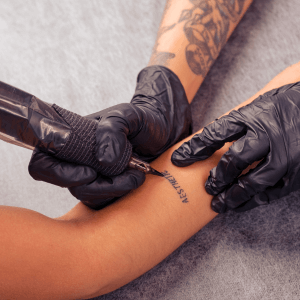|
CRPS and tattoos
With the ever-increasing popularity of tattoos, one man’s experience is a word of caution. Derek contacted me to say that he would like to share with others a potential risk factor in having a tattoo. It’s a risk that had neither occurred to him nor was mentioned before the procedure.
 Last year, after considerable deliberation, Derek finally took the plunge and had his first-ever tattoo, a relatively modest one on his right forearm. He was instructed on ‘wound care’ whilst it healed. The tattooist also told Derek that his arm would be sore for a couple of weeks and possibly a little longer.
Last year, after considerable deliberation, Derek finally took the plunge and had his first-ever tattoo, a relatively modest one on his right forearm. He was instructed on ‘wound care’ whilst it healed. The tattooist also told Derek that his arm would be sore for a couple of weeks and possibly a little longer.
But the soreness did not subside as expected. Instead, the pain steadily increased, and he noticed swelling in his forearm and hand. Believing he had an infection, Derek visited his doctor, who agreed that an infection was indeed the most likely cause. The doctor prescribed antibiotics, but they produced no noticeable effect.
Remission
It was at this point that Derek remembered experiencing similar symptoms many years before, following surgery on his other (left) wrist. Going back through his records, his doctor advised him that following surgery, he had been diagnosed with Complex Regional Pain Syndrome (CRPS). Fortunately, his symptoms had gone into total remission.
Unfortunately, following his tattoo, history had repeated itself.
CRPS and tattoos: higher risk
Research suggests that the chance of CRPS recurring following remission is greater than the chance of it occurring for the first time. Also, if it does recur following a period of remission, it won’t necessarily recur at the same site and may recur spontaneously.
Derek accepts that the recurrence of CRPS near the tattoo may be entirely coincidental, but it’s a huge coincidence. Indeed, those now treating him in the pain clinic attribute the tattoo as the trigger.
Informed consent
 A tattoo is no different from any surgical procedure, and recipients must give informed consent. This is a process in which the person receives important information about the forthcoming procedure, including possible benefits and risks. Informed by that information, they can then choose whether to consent to proceed. The signing of a consent form is evidence of consent.
A tattoo is no different from any surgical procedure, and recipients must give informed consent. This is a process in which the person receives important information about the forthcoming procedure, including possible benefits and risks. Informed by that information, they can then choose whether to consent to proceed. The signing of a consent form is evidence of consent.
In the UK, tattoo artists remain primarily self-regulated, and no standard consent form exists. From what I can gather – and as might be expected – warnings on tattooists’ consent forms tend to relate only to common health conditions/risk factors, certainly not the risk of susceptibility to CRPS.
Avoid unnecessary trauma
Statistically, the chance of CRPS recurring is relatively high. That doesn’t mean to say that people in total or partial remission should wrap themselves in cotton wool. However, Derek believes that more should be done to highlight the heightened risk they face and avoid subjecting themselves to unnecessary bodily trauma. Of course, that isn’t limited to tattoos. Other cosmetic procedures pose a similar risk, body piercing being another obvious example.

 CRPS and Tattoos: Andrew Atkinson considers how cosmetic procedures that pierce the skin carry the same risks of triggering CRPS in susceptible people as regular surgery.
CRPS and Tattoos: Andrew Atkinson considers how cosmetic procedures that pierce the skin carry the same risks of triggering CRPS in susceptible people as regular surgery.